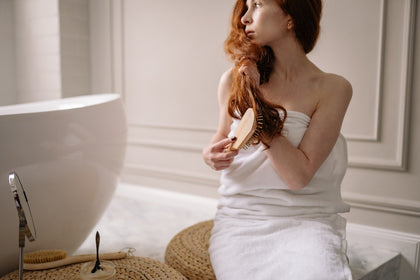Most people are used to picking up their hairbrush and seeing a tangled mess of hair in the brush bristles when they go to brush their hair every day. The average person sheds between 50 and 100 hairs daily, with many of those hairs ending up on your brush or comb.
Not cleaning your hair tools properly can result in a build-up of bacteria that can be dangerous for people with scalp issues. Read on to find out about the best way to clean these highly used bathroom accessories. Plus, discover the best products for maintaining healthy, beautiful hair.
Why Cleaning Your Hair Brushes Is Important
If you've ever cleaned your hair tools, you know there's a lot more than just hair follicles clogging up your comb. Most of the "gunk" in your hair brush is dead skin cells, hair product residue, scalp oil and broken hair clumps. Additional bacteria and fungus can grow within that collection of gunk inside your brush, which, in addition to being gross, is problematic for people who have a sensitive scalp or skin. The lingering bacteria can get into the hair follicles on your head and cause flare-ups for people who have scalp conditions like dandruff or seborrheic dermatitis.
"There are a few reasons why it's important to clean your hairbrush," said hair expert and creative director of WigReports Lauren Udoh. "First of all, if you don't clean your hairbrush regularly, it will become a breeding ground for bacteria and fungi. This can cause scalp problems, including dandruff, and lead to hair loss."
"Secondly, cleaning your hairbrush helps eliminate built-up products, dirt and oils," said Udoh. "This will help keep your scalp healthy and free of product buildup, and also help your hair look shiny and smooth."
@vegamour Did you know you should be washing your combs and brushes at least once a month?! While cleaning your brush or comb might not be high on your list of beauty-related priorities, it's an important and highly underrated step for overall cleanliness and brush performance. Brushes that are too saturated with hair aren't able to brush your hair as thoroughly and could end up spreading that bad bacteria all over your clean hair and scalp each time you brush. @The Hair Aesthetic ♬ son original - quentin
How Often You Should Clean Hairbrushes and Combs
While cleaning your brush or comb might not be high on your list of beauty-related priorities, it's an important and highly underrated step for overall cleanliness and brush performance. Brushes that are too saturated with hair aren't able to brush your hair as thoroughly and could end up spreading that bad bacteria all over your clean hair and scalp each time you brush.
Cleaning your combs and brushes thoroughly at least once a month can prevent scalp irritation and encourage healthy hair growth. If you have lots of hair or tend to use a lot of product to style your hair, you might want to consider a more frequent cleaning.
Shop: Hair Comb
How To Clean Hairbrushes and Combs
Methods for cleaning brushes and combs differ depending on the type of brush or comb you have and the materials it's made from. Cushioned brushes that are made from plastic with synthetic bristles are easiest to clean, while brushes made with a wooden handle or with natural materials require some additional TLC.
For synthetic brushes, you'll want to soak them as part of your cleaning routine. Avoid soaking or submerging natural fibers or wood brushes in water, as this can cause damage that could shorten the life of your brush.
How to Clean Synthetic Brushes and Plastic Combs
- Remove the dead hair from the brush with tweezers, your fingers or with a pintail comb if needed.
- Fill the sink or a large bowl with warm water and then add about two tablespoons of shampoo. Wash brush or comb in a mixture of hot water and gentle shampoo. You can swish the brush or comb in the water to create some suds.
- Soak the brush or comb in the soapy water for approximately 15 minutes.
- If there's some stubborn product stuck on your comb or brush, try dipping an old toothbrush into some dry baking soda, using the gritty solution to exfoliate the residue off of your comb or brush.
- Rinse the brush or comb thoroughly with warm water. Give it a good shake to remove any excess moisture, then place it on a towel with the bristles facing downward.
- Allow it to dry overnight.
- To kill any remaining bacteria, combine a little bit of white vinegar or rubbing alcohol with clean water into a sink or bowl. Dip the bristles or comb in the solution. Allow it to air dry overnight or until it's completely dry. Paddle brushes with cushy bases tend to trap water so be sure to dry each brush thoroughly.
Shop: GRO Dry Shampoo 3-Pack
How to Clean Wooden Brushes or Combs Made From Natural Materials
- Remove the dead hair from the brush with tweezers, your fingers or with a pintail comb if needed.
- Wash brush or comb in a mixture of hot water and gentle shampoo. Fill the sink or a large bowl with warm water and then add about two tablespoons of shampoo. Be careful not to get the wooden handles in the soapy water.
- Lightly scrub the brush or comb to remove all the residue with an old toothbrush or smaller brush. This can be done by dipping a toothbrush in baking soda or using a small dab of dish soap. Gently scrub the bristles.
- Rinse the brush or comb thoroughly with warm water. Give it a good shake to remove any excess moisture, then place it on a towel with the bristles down.
- Dry overnight.
- For extra sanitization, mix white vinegar or rubbing alcohol with clean water and spray the brush bristles or comb. Air dry overnight or until it's completely dry.
Read: When to Use a Comb vs. Brush
Natural Products to Help Maintain Healthy Scalp and Hair
In addition to cleaning your brushes and combs regularly, the best way to maintain good hair health is with products that promote a healthy, balanced scalp. If you're looking for a natural approach to hair health, consider starting with VEGAMOUR's GRO Revitalizing Shampoo and Conditioner Kit. The duo is safe for all hair types, including color-treated hair, and is free of all the questionable ingredients you can’t pronounce. Instead, it harnesses the power of plant-based and our proprietary Karmatin™, the first-of-its-kind vegan keratin. Featuring wild harvested marula oil, organic murumuru butter and ximenia oil, this pair helps to condition, hydrate and fight damaging free radicals without imparting pore-blocking residue.
Take Care of Your Hair — and Hair Tools
Caring for your hair goes far beyond what products you use and how often you get a haircut. Diet, exercise, stress management and a healthy lifestyle will all help encourage your follicles to grow to their very best ability. If you want to ensure the health of your hair and scalp, make sure to clean your brushes and combs at least once every month.
#include-related-slider#
More From VEGAMOUR
- Shop: Our Favorite Clean Hair Care Products
- How and Why to Plop Your Curly Hair
- Getting to The Root of Natural Hair Breakage
- 33 Protective Styles for Natural Hair
Photo credit: Yan Krukov/Pexels




















